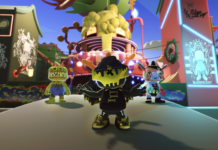Game demos are tricky. Often, you’re spending more time learning the mechanics and getting your bearings than coming to any kind of value judgment. That’s what’s so great about Dungeon Defenders II – right from the start things made sense, and within minutes I was strategizing, utilizing the game’s new combo system, and keeping my team afloat like a boss. Not every game can be so immediately inviting, but I love that Dungeon Defenders II is.
The game also looks beautiful. With a focus on PC and Mac this time around, the developers have been able to build environments that feel full, with long draw distances and the same appealing art style. It's is colorful, and overall it’s just nice to look at.
Dungeon Defenders II continues the basics the series is known for. Four players choose from four classes and take on waves of enemies in a blend of tower defense and third person action-RPG combat. From there, every aspect of the game is improved for more fun and more strategy.

For one, while the game has the standard build phase between waves of enemies, any player can build, upgrade, and repair their towers at any point. The result is that right from the start you’re busy – you won’t be waiting around for the later phases when things get more hectic. There’s always something you can be doing, and the line between action and strategy is blurred in a really smart way.
That more intelligent blending of action and tower defense is an explicit goal for Dungeon Defenders II, and it bleeds into all aspects of the gameplay. Character abilities and their towers blend together, allowing you to create combos for extra damage. For example, I played as the Monk during my demo, a healer who focuses on anti-air. At first, I didn’t think an anti-air character would be very useful. That changed when another hero dropped defenses that launched enemies into the air. These combos are key to creating smart strategies.
While certain towers work well together, the game also allows players to combo their abilities. Returning to that anti-air tower example, a player could find a weapon that launches enemies into the air, blending the tower strategy with action. In addition, character abilities often have two functions. The Monk’s blowback attack also buffs towers, allowing you to knock enemies away from your defenses while powering up your towers.

Arena designs include multiple routes and attack points for enemy waves, and while the goal is to protect a main base, there are secondary bases that you’ll want to protect as long as possible. Once they fall, you’ll have all those side lanes of enemies heading toward your main base. This keeps everyone moving around the map, splitting up and focusing on certain areas. There’s an interesting challenge here, because you’ll want to split up, but if you don’t pay attention to the rest of the map, you’ll miss out on combo opportunities. Again, while the game is easy to learn, the action is complex enough that you’ll be running all over the place and strategizing throughout a match.
While the original Dungeon Defenders didn’t quite grab me, Dungeon Defenders II has me immediately excited. It looks beautiful, it’s fun right away, and it’s a lot better than Trendy’s original idea of turning Dungeon Defenders into a MOBA. I originally considered asking the developers if they thought tower defense was a waning genre, but Dungeon Defenders II told me that the genre still has plenty of great things to offer.
Enjoy random thoughts about the latest games, the Sega Saturn, or the occasional movie review? Follow me @JoeDonuts!










